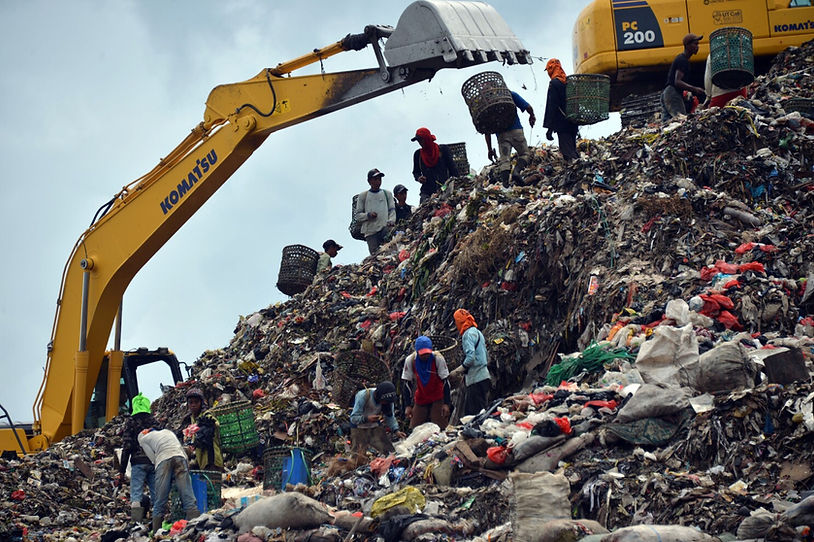By: Eric Weinberg
Ever since the Industrial Revolution started in the mid-18th century, we have struggled with maintaining and disposing of human waste. As factories and individuals began using single-use items, we have to put them somewhere after they no longer have any use for us, or we just don’t want them. And as the years have gone on and as our population increased and people began to discard more items away, we have collected mass amounts of waste that sometimes do and sometimes don’t degrade. Plastics and polystyrenes cannot degrade in short periods, usually about 450 years, according to the Washington Post.
According to the Business Insider, in 2013, over 294 million tons of waste ended up in landfills. For the past 30 years, large masses of trash like this every year have been sent to landfills. Before plastic and other non degradable materials were widely used, there still were large amounts of trash collected, leading to the unimaginable amount of garbage we have collected in the world. Humans have had no solution to this crisis, and to get rid of the trash we have been burning, it releases harmful gasses called greenhouse gasses that trap heat on Earth and alter the climate. Their buildup will eventually make Earth uninhabitable for humans according to the Science Daily. Recently, scientists have had a breakthrough and found enzymes that could be able to break down the trash into organic, degradable waste.
According to Britannica, enzymes are molecules that accelerate chemical reactions. Enzymes are everywhere in living organisms. They are usually part of the digestive system and can break down food in an organism’s digestive tracts. Scientists around the world are now trying to find bacteria and bugs that contain enzymes that would be able to break down common materials found in waste. According to The Washington Post, scientists have begun studying and conducting studies on these organisms that could get rid of huge amounts of waste. They could eradicate Styrofoam, plastic bottles, and many other objects that end up in landfills. Although they may not be able to eradicate everything, they could eradicate a vast majority of it. These enzymes could be the key to ending the garbage crisis.
This solution is also very helpful for the Earth. According to the Washington Post, the “super worm’s” enzymes convert the trash into organic waste or feces that will degrade as a fertilizer and make the soil in its area richer and more nutritious for organisms to thrive there. Overall, this solution is the best for the Earth and will effectively, with no issues, get rid of waste and turn it into something helpful for the Earth, which is the best we can hope for.
Another reason why we should use enzymes to get rid of garbage is that it is efficient. Although it would not be cost-efficient to separate the different garbage components such as Styrofoam and plastic, the other steps of the process would be extremely efficient. There would most likely be a large vat containing the enzymes necessary, and they would degrade the garbage. Let us consider a solution that would not be as efficient as this, such as sending the trash out of Earth’s orbit and into the Solar System. This would be incredibly expensive according to Discovery Magazine, costing over 33 quadrillion dollars per year and would not get rid of the trash as rapidly.
The final reason is that according to my collected research from the Washington Post, Britannica, Forbes, and Science Daily, it’s the only solution humanity has to effectively get rid of most of the trash and keep the stream of garbage underway without contributing to climate change. Humanity does not have that many options to choose from, and if people are not willing to start recycling what needs to be recycled, not using plastic water bottles once, and garbage management companies are not willing to pay extra money to recycle plastics and Styrofoam then what are we going to do?
Sadly, the enzyme solution is not perfect. It is not an instant seamless solution to end the whole garbage crisis. We are exploring unknown territory here; we understand the chemistry of it, but it will take more time and studies to fully address this solution. It is not guaranteed that the gut enzymes of super worms and mealworms will be able to break down plastics, especially in large quantities and at very high speeds. Although this is a good point, at this point, there is just as much guarantee that the enzymes will perform and break down these plastics at a rapid rate and degrade huge quantities of it, according to the Science Daily and Chemistry-Europe.
For the enzymes to do their job, the garbage would also have to be separate, which could be costly. Sadly, there is no way to avoid the prices. Possibly in the next five to ten years, as we are working on industrializing this solution, we will be able to find a solution to this problem. But we could also avoid sending the enzymes to the landfills altogether by making composting kits that would contain these enzymes, mealworms, and super worms that would break down people’s trash in their very own homes. So, no matter what, I think that enzymes are the solution to one of the world’s biggest problems, the garbage crisis.











